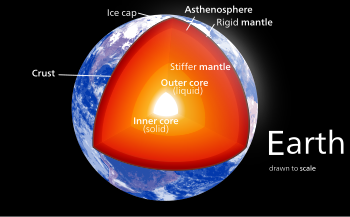Мантия (геология)
Мантия ограниченный — слой внутри планетарного тела, снизу ядром и сверху корой . Мантия состоит из камня или льда и обычно представляет собой самый большой и массивный слой планетарного тела. Мантии характерны для планетных тел, подвергшихся дифференциации по плотности . Все планеты земной группы (включая Землю ), ряд астероидов и некоторые спутники планет имеют мантию.
Примеры
Земля

Мантия Земли представляет собой слой силикатной породы между земной корой и внешним ядром . Его масса 4,01×10. 24 кг составляет 67% массы Земли. [1] Его толщина составляет 2900 километров (1800 миль). [1] составляя около 84% объема Земли. Он преимущественно твердый, но в геологическом времени ведет себя как вязкая жидкость . Частичное плавление мантии в срединно-океанических хребтах образует океаническую кору , а частичное плавление мантии в зонах субдукции образует континентальную кору . [2]
Другие планеты
Меркурий имеет силикатную мантию толщиной около 490 километров (300 миль), что составляет лишь 28% его массы. [1] Силикатная мантия Венеры имеет толщину примерно 2800 километров (1700 миль), что составляет около 70% ее массы. [1] Силикатная мантия Марса имеет толщину примерно 1600 километров (990 миль) и составляет ~74–88% его массы. [1] и могут быть представлены хассигнитовыми метеоритами. [3]
Луны
Юпитера Спутники Ио , Европа и Ганимед имеют силикатную мантию; Силикатная мантия Ио размером примерно 1100 километров (680 миль) покрыта вулканической корой, силикатная мантия Ганимеда толщиной примерно 1315 километров (817 миль) покрыта льдом примерно 835 километров (519 миль), а Европы примерно 1165 километров (724 мили). Километровая силикатная мантия покрыта примерно 85 километрами (53 милями) льда и, возможно, жидкой воды. [1]
Силикатная мантия Луны Земли имеет толщину примерно 1300–1400 км и является источником морских базальтов . [4] Лунная мантия может быть обнажена в бассейне Южного полюса-Эйткена или в бассейне Кризиума . [4] Лунная мантия содержит сейсмический разрыв на глубине около 500 километров (310 миль), скорее всего, связанный с изменением состава. [4]
Титан и Тритон имеют мантию, состоящую из льда или других твердых летучих веществ. [5] [6]
Астероиды
Некоторые из крупнейших астероидов имеют мантию; [7] например, Веста имеет силикатную мантию, близкую по составу к диогенитовым метеоритам. [8]
См. также
- Внутренний тепловой баланс Земли
- разрыв Лемана
- Мантийные ксенолиты
- Мантийная конвекция
- Мезосфера (мантия)
- Численное моделирование (геология)
- Примитивная мантия
Ссылки
- ↑ Перейти обратно: Перейти обратно: а б с д и ж Катарина., Лоддерс (1998). Спутник планетолога . Фигли, Брюс. Нью-Йорк: Издательство Оксфордского университета . ISBN 978-1423759836 . OCLC 65171709 .
- ^ «Из чего состоит мантия Земли? – Вселенная сегодня» . Вселенная сегодня . 26 марта 2016 г. Проверено 24 ноября 2018 г.
- ^ Мошенничество, ТД (1 января 2002 г.). «Марсианские благородные газы» . Обзоры по минералогии и геохимии . 47 (1): 171–190. Бибкод : 2002RvMG...47..171S . дои : 10.2138/rmg.2002.47.6 . ISSN 1529-6466 .
- ↑ Перейти обратно: Перейти обратно: а б с Вечорек, Массачусетс (1 января 2006 г.). «Конституция и структура лунного интерьера» . Обзоры по минералогии и геохимии . 60 (1): 221–364. Бибкод : 2006RvMG...60..221W . дои : 10.2138/rmg.2006.60.3 . ISSN 1529-6466 .
- ^ «Слои Титана» . НАСА . 23 февраля 2012 года. Архивировано из оригинала 14 сентября 2015 года . Проверено 7 октября 2015 г.
- ^ «Тритон: Подробно» . НАСА . Архивировано из оригинала 17 ноября 2015 года . Проверено 16 октября 2015 г.
- ^ «Обсерватория Гриффита – Частицы неба – Истории метеоритов» . www.griffithobservatory.org . Архивировано из оригинала 10 февраля 2020 г. Проверено 24 ноября 2018 г.
- ^ Редди, Вишну; Натюс, Андреас; Гаффи, Майкл Дж. (01 марта 2011 г.). «Обнаружен первый фрагмент мантии астероида 4 Весты». Икар . 212 (1): 175–179. Бибкод : 2011Icar..212..175R . дои : 10.1016/j.icarus.2010.11.032 . ISSN 0019-1035 .
Дальнейшее чтение
- Дон Л. Андерсон , «Теория Земли» , Блэквелл (1989), представляет собой учебник, посвященный недрам Земли, и теперь доступен в Интернете. Проверено 23 декабря 2007 г.
- Жанлоз, Раймонд (2000). «Мантия Земли». В Харальдуре Сигурдссоне; Брюс Хоутон; Хейзел Раймер; Джон Стикс; Стив МакНатт (ред.). Энциклопедия вулканов . Сан-Диего: Академическая пресса . стр. 41–54. ISBN 978-0-12-643140-7 .
- Никсон, Питер Х. (1987). Мантийные ксенолиты: J. Wiley & Sons , 844 стр., ( ISBN 0-471-91209-3 ).
- Дональд Л. Теркотт и Джеральд Шуберт , Геодинамика, издательство Кембриджского университета , третье издание (2014 г.), ISBN 978-1-107-00653-9 (в твердом переплете) ISBN 978-0-521-18623-0 (мягкая обложка)
Внешние ссылки
- Самые большие раскопки: Япония строит корабль для бурения мантии Земли - Scientific American (сентябрь 2005 г.) (архивировано 17 октября 2007 г.)
- Информация о проекте Мохоле (архивировано 2 ноября 2015 г.)